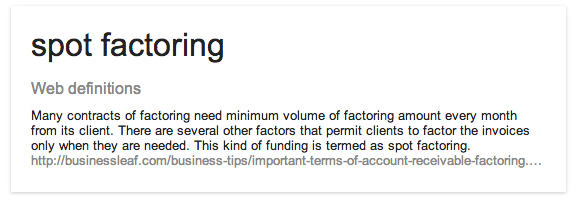

If one of the main benefits of factoring is that you don't have to worry about collections on your invoices, the flip side is that you lose control over the collections on your invoices.ĭepending on your contract with the factoring company, you may be giving up communications with your customer. In an industry where there's not a lot leftover for the contractors when the job's all done, adding another cost is not ideal. Factoring fees are generally costlier than the interest on a business loan – often running 1-4% of the face value of the invoice for every week or month the cash is outstanding. The main downside of invoice factoring is pretty obvious: you are losing out on a portion of your revenue. Finally, you don't have to leverage your capital assets to secure cash when you use factoring like you may have to do to secure a bank loan. There are other ways to get cash, like a business loan, but factoring is often faster and more accessible than getting a business loan. Factoring gives you access to cash, which can help bridge the funding gap. And yet, the expenses keep coming: labor, materials, and equipment costs, to name a few. It can take months to get paid in construction after a company submits an invoice to a client. Factoring takes the collection's process off your hands.Įxtra cash at a critical point in a project can be a huge advantage. First, collecting on unpaid bills is nobody's idea of a good time. There are a lot of benefits to this type of transaction. Is invoice factoring in construction a good idea? You may have to find some cash to cover ongoing expenses in these situations. Maybe an expensive tool just broke, or a project has a spontaneous design change that will jack up the costs. You may be a cash flow ninja, but now and again, every business sees an unexpected expense. Factoring can help keep the cash coming in at regular intervals to pay for this change. Taking on more extensive work means new equipment, more laborers, and more administrative fees, but the more significant money won't start flowing until after the work is well underway. The only way to grow a contracting business is to keep bidding on larger projects, but that growth requires a bit over overhead. If you have trouble making this work, you might consider factoring, which can help keep payments stable and predictable so you can cover operational expenses. Why you might consider factoring Keep the wheels turningĬash Flow is king in construction, but as complex as the projects are, it's tough to maintain a balance between payments coming in, well, whenever they come in, while expenses keep rolling out on a regular schedule. The fees for contract factoring will be lower than the cost of spot factoring, so if you want to use the service often, it may be the best choice. Rather than waiting for the net 60 terms to close, a contractor may choose contract factoring to get paid just days after an invoice is submitted. Contract factoringīy contrast, contractors may use contract factoring when a company hopes to use factoring regularly to speed up payment on all their invoices. For example, a business owner may use spot factoring when a sudden, unexpected expense emerges, but the business is unlikely to use the service regularly. Spot factoringĬontractors use spot factoring to bridge a one-off gap in the cash flow. Types of factoringįactoring contracts typically fall into one of two categories: spot factoring or contract factoring. Here we’ll talk about why a contractor might consider factoring, the benefits and risks to its use, and alternative methods of accessing cash. However, it shouldn’t be taken lightly, as it comes with its own costs and risks. At this time, the company will pay you the remaining money owed minus a fee, which is usually a percentage of the invoice amount.įactoring can be a useful financial tool for a contractor, by helping to cover costs when money’s tight. Your clients then pay the factoring company directly. In invoice factoring, you give over your outstanding balances to a factoring company, which pays you a portion of the balance in cash immediately. It’s a way to turn unpaid invoices and accounts receivable into quick cash for a cost. Invoice factoring is like borrowing against your receivables. One of those methods is called invoice factoring. Contractors have come up with a few ways around this problem to keep a project running in the face of a cash flow crunch.

This can present a problem when companies find they run out of money to cover their expenses. While money tends to come in at fits-and-spurts, it flows out fast. Sometimes the biggest challenges for construction companies come from the flow of money in and money out.


 0 kommentar(er)
0 kommentar(er)
